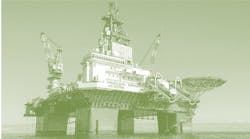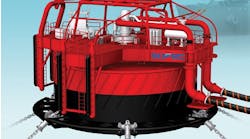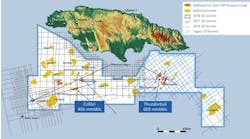Asia-Pacific
Murphy Oil Corp. subsidiary Murphy Sabah Oil Co. Ltd. awarded a contract for an FPSO to be used on the Kikeh development offshore Malaysia. Malaysia International Shipping Corp. (MISC) Berhad won the contract. IHC Caland subsidiary Single Buoy Moorings Inc. is MISC’s technical partner. The contract includes the vessel charter as well as the operation and maintenance work.
The FPSO will have the facilities to process 120,000 b/d of oil and will be fitted with high-capacity water and gas treatment facilities with associated reinjection plants. The vessel will have storage capacity in excess of 1.5 MMbbl. The unit will be designed to remain on site for 20 years. Delivery is scheduled for the second half of 2007. Malaysia Shipyard and Engineering Sdn Bhd. will perform all construction, outfitting, and integration work for the FPSO.
Murphy also awarded Technip a contract for Kikeh. Technip will build the first spar to be installed outside the Gulf of Mexico. The contract covers engineering, construction, and installation of a spar complete with topsides facilities, hull, mooring system, and riser/wellhead systems.
Technip’s engineering center in Kuala Lumpur will engineer the spar topsides and will manage the entire project. Technip’s Houston and Finland offices will provide specialist support, performing the global and riser system engineering and the detailed engineering for the hull. Malaysian Shipyard and Engineering Sdn Bhd will build the spar hull and topsides.
The Kikeh spar hull will be 142 m long, with a diameter of 32 m and a steel weight of 12,000 tonnes. The topsides facilities will weigh 3,000 tonnes and provide a 25-slot well bay for dry tree wellheads. Hull delivery is scheduled for 2006, with first production planned for the second half of 2007.
Petronas approved the full Kikeh area field development plan last November. Kikeh is the first deepwater field to be developed off Malaysia and has a recoverable reserve base in excess of 400 MMbbl with associated expansion capability. Murphy operates Kikeh with 80% working interest. Petronas holds the remaining 20%.
null
While Murphy moves Kikeh into production more players are getting into the deepwater game. Petronas awarded two PSCs to Shell and Petronas Carigali Sdn Bhd for ultra-deepwater blocks ND6 and ND7 offshore the east coast of Sabah.
The 8,700-sq-km block ND6 and 17,000-sq-km block ND7 are in 200-4,000 m of water in the Tarakan basin.
Under the terms of the PSCs, Shell and Petronas will jointly operate the blocks.
After a half-decade hiatus, crude oil production from India’s Mumbai High field has reached 270,000 b/d.
Mumbai High, one of the most prolific producers of sweet and light crude in the world, was brought into production in 1976. Production began declining in the 1990s, but management decisions to apply a large number of technologies helped India’s Oil and Natural Gas Corp. bring field production numbers back up.
Fast-track adoption of new technologies has increased production at Mumbai High over 55,000 b/d in the last three years.
ONGC expects Mumbai High to reach 300,000 b/d production in 2005-06.
Central Asia
The Azerbaijan International Operating Co. (AIOC), operated by BP, announced the start-up of oil production from the Central Azeri development, part of the Azeri-Chirag-Gunashli (ACG) field, in the Azerbaijan sector of the Caspian Sea.
Located in 128 m of water 100 km east of Baku, Central Azeri production began from the first of 10 pre-drilled production wells Feb. 13. Production will increase through 2005 as the other pre-drilled wells are brought online, prior to further platform drilling over the coming years. Total production from Central Azeri is forecast at 35 MMbbl in 2005, about 93 000 b/d.
“The start-up of Azeri is an exciting moment both for Azerbaijan and BP as operator of the ACG project,” David Woodward, BP’s associate president in Azerbaijan says. “It signals the beginning of oil production from the ACG full field development and the culmination of many years of planning, construction, and operations delivery.”
The Central Azeri facilities comprise a 48-slot production, drilling, and quarters (PDQ) platform, a 30-in. oil pipeline, and a 28-in. gas pipeline from CA to the Sangachal terminal. Processed oil from Sangachal will initially be transported to market via existing export routes and through new export routes once the Baku-Tbilisi-Ceyhan pipeline is operational later this year. The development is designed to process 420,000 b/d of oil. Gas produced from Central Azeri, beyond that used for reservoir pressure maintenance and fuel, will be exported via the new 28-in. subsea pipeline into the Sangachal Terminal gas processing facilities.
In addition to the PDQ, a compression and water injection platform will be installed in Central Azeri in 3Q 2005 and will be bridge-linked to the PDQ to create a major offshore complex encompassing accommodation, drilling, production, processing, compression, and re-injection facilities.
BP operates the ACG PSA with 34.1% interest. Partners include Unocal with 10.3%, Socar with 10%, Inpex with 10%, Statoil with 8.6%, ExxonMobil with 8%, TPAO with 6.8%, Devon with 5.6%, Itochu with 3.9%, and Amerada Hess with 2.7%.
Africa
Sociedade Nacional de Combustíveis de Angola and BP discovered oil with the Palas-1 well in deepwater block 31, offshore Angola.
Palas-1 is the fifth successful discovery BP has drilled in block 31, following Plutão, Saturno, Marte, and Venus. Palas-1 is 62 km southeast of the Plutão discovery in a potentially new development area in the southeastern part of the block.
Ocean Rig’s semisubmersible,Leiv Eiriksson, drilled Palas-1 in 1,602 m of water 325 km northwest of Luanda, reaching a total depth of 3,745 m. The well tested at a maximum rate of 5,330 b/d of oil through a 40/64-in. choke. BP will carry out further testing to evaluate the full extent of the Palas discovery.
Sonangol is the concessionaire of block 31. BP as operator, holds 26.67% interest. Partners in block 31 are Esso Exploration and Production Angola (block 31) Ltd. with 25%, Sonangol E.P. with 20%, Statoil Angola A.S. with 13.33%, Marathon Petroleum Angola Ltd. with 10%, and TEPA (block 31) Ltd. with 5%.
Europe
Norway’s Ministry of Petroleum and Energy approved Statoil’s plans for development and operation (PDO) for two North Sea projects.
One plan covers the Skinfaks satellite close to Gullfaks, and the other modifies the original PDO for the nearby Rimfaks satellite. Both fields will be tied back to Gullfaks C.
“Developing Skinfaks and Rimfaks helps to exploit the infrastructure in our area,” says Lars Christian Bacher, operations vice president for Gullfaks. “It provides good resource utilization for a limited investment. And tail production on Gullfaks will also be strengthened.”
Total investment in the two fields is placed at NKr3.4 billion, with recoverable reserves estimated at about 70 MMboe.
Transocean won the drilling contract for the two wells in January. FMC Kongsberg Subsea won the subsea installations contract last December. The drilling program is to start this fall, with production from the two satellites to begin in November 2006.
Statoil operates the fields with 61% interest. Partners include Petoro with 30% interest and Hydro with 9%.
The Peak Group secured a major contract with Burlington Resources Irish Sea Ltd. to plan and manage three gas wells in the East Irish Sea.
The work consists of one development well on the Dalton field 25 mi west of Walney Island, Barrow, followed by two exploration wells on the Asland and Kelly prospects between the British mainland and the Isle of Man. Burlington Resources holds eight licenses in the East Irish Sea, covering 239,000 acres.
The Peak Group will deliver a complete well project management service that includes detailed well and test design, tendering and contracting for all services, and executing the drilling program, including materials and logistics, project completion, and operations wrap-up. The work is expected to take five months.
Middle East
Egypt’s 2004 bidding round landed Burren an offshore license in block 2, known as North Hurghada Marine, in the Gulf of Suez.
The offshore area covers 242 sq km in shallow water and lies along the same trend as Zeit Bay and Geisum - two well-known oil production areas. Immediately southeast of North Hurghada Marine lies the significant Seabird gas and oil field.
Block 2, along with an onshore block nearby, will increase Burren’s presence in Egypt.
Meanwhile, Regal received final assignment of the East Ras Budran area in the Gulf of Suez from the Egyptian government.
The company identified four large prospective structures and is reprocessing and interpreting seismic data. Exploration drilling is expected to start late this year, with a total work commitment set at $4 million.
The concession area is a prolific petroleum province. Nearby oil fields include Ras Budran, October, Abu Rudeis, Belayim Onshore, and Belayim Offshore, which range from 270 MMbbl to over 1 Bbbl in recoverable reserves.
The East Ras Budran concession area contains four large prospects identified following the evaluation of existing data.
At present, Regal has no development work or production ongoing in Egypt.
Mediterranean
Off Egypt’s Mediterranean coast, Atwood Oceanics Inc.’sAtwood Hunter semi won a contract from Burullus Gas Co. to drill two wells.
The contract requires a rig upgrade that includes high-pressure capability that will allow the vessel to drill wells with a psi of 15,000. The $8-million upgrade includes equipment installation that is to begin in 3Q when the rig completes its current drilling program, also with Burullus.
Americas
Petrobras is entering into a joint venture with Repsol YPF to develop gas in the Santos basin.
Petrobras explains that with its current business plan, various alternatives are under study regarding developing gas reserves in the Santos basin and to supply the Brazilian natural gas market, which takes into account the possible use of all gas reserves in the Southern Cone, including Brazil, Bolivia, and Argentina.
Petrobras began negotiations with Repsol because of Repsol’s experience in natural gas production and the company’s strategic position in the Southern Cone gas market. Repsol jointly participates with Petrobras in producing and selling Bolivian gas to Brazil.
China boosts production
CNOOC’s business strategy and development plan for 2005 features a primary goal of boosting production. The budgeted figure for 2005 is 141-146 MMboe, about a 19% year-on-year increase over 2004’s budget of 118-123 MMboe.
The company says 2005 will be a significant year for production growth. Sixteen development projects are expected to come onstream between 2005 and 2006, of which nine should be completed this year alone. The 2005 project total is the highest ever planned for completion in a single year. CNOOC’s 2005 capital budget supports the growth with capital expenditure budgeted at $2.2 billion, a 33% increase over 2004. The exploration budget is expected to remain at $260 million, but the exploration program will focus on new exploration plays, including deepwater prospects offshore China. The objective is to achieve a reserve replacement ratio of 150%.
“We will continue to maintain our competitive cost structure and take all necessary measures to ease the upward pressure,” says Yang Hua, CFO and senior vice president.
One significant goal, the company says, is to further implement its natural gas strategy and be the leading gas supplier in coastal China. CNOOC expects to complete acquisition of the Gorgon equity interests, which along with the Tangguh and North West Shelf acquisitions will further secure LNG supplies with natural gas production increase. CNOOC’s grip on China’s pioneer LNG projects could further strengthen the company’s leadership in LNG imports and its dominance in coastal China natural gas market.
According to Fu Chengyu, chairman and CEO, “CNOOC Ltd.’s sustainable growth platform remains stable. We will continue to focus on production and reserves growth, maintaining competitive cost structure, and implementing our natural gas strategy. The management continues to be confident of the growing future of the company.”
Murphy’s Kikeh development in block K offshore Sabah will be Malaysia’s first deepwater development.
Faroe Petroleum’s new acreage position in the central North Sea, previously owned by Shell and Esso.




